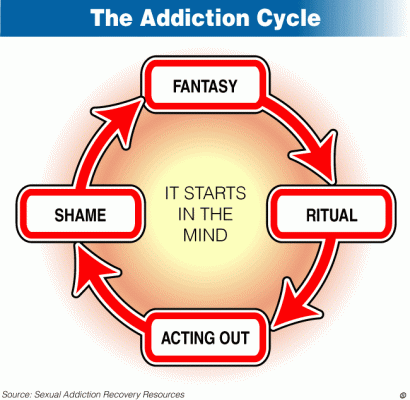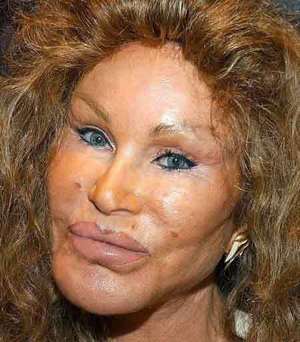Celebrities and addiction continue to be media’s favorite cocktail. But it’s not the Courtney Loves and Nicole Richies that excites them anymore. Alcoholics and drug addicts do get coverage on the inside pages and the last sections of news bulletins, but the headlines have now been grabbed by other modern addictions.
Don’t we all want updates on Tigers Woods’ sex addiction, Lindsay Lohan’s shopping sprees and Donatella Versace’s “want-to-look-like-an-alien” addiction? Sorry, we messed up with Versace- addiction to plastic surgery would be a more apt description.
But it’s not just the celebrities bringing these addictions to the headlines, are you a victim to any of the ten listed below?
10. Workaholism (Work Addiction)
Workaholics often earn respect in the modern commercial world, where every second is your chance to earn more. But this excessive commitment to labor draws every bit of energy from the addict. The lines between hard work and workaholism begin to blur. Workaholics, like other addicts, get a reality jolt only when something critical happens to their health and relationships.
In Japan, they have a word for that fatal blow. It’s called Karoshi or “death by overwork”. The phenomenon created a stir when in 1980’s a few Japanese executives died without any history of illness.
Workaholic Anonymous, a self-help group, provides a 12-step treatment plan for workaholics.
9. Love Addiction
There is only one a slight difference between a love addict and a jilted lover. The love addict will never let it go, affecting his health and relationships until he falls in love again (and that might take a long time).
A recent CNN report (“Love Addiction – How To Break It”) quoted Psychology Today, explaining how infatuation can produce a rise in phenylethylamine (PEA), a neurological chemical that gives euphoria when someone falls in love.
The report also featured the study done by anthropologist Helen Fisher who found that people who are infatuated share symptoms with cocaine abusers, like sleeplessness and loss of sense of time.
The addiction has fueled the growth of self-help groups and therapists trained in love addiction. Currently, Sex and Love Addicts Anonymous offers a 12-step program for recovery.
8. Television Addiction

“The problem with television is that people must sit and keep their eyes glued to the screen; the average American family hasn’t time for it. Therefore the showmen are convinced that for this reason, if no other, television will never be a serious competitor of broadcasting” (New York Time Editorial, 1939).
Today, an average American watches his TV set for more than four hours a day, if one A.C. Nielson Co. survey is to be believed. This means that by the age of sixty-five this sad old man would have spent nine years of his life glued to the “idiot box”.
TV addicts share many clinical abuse symptoms like helplessness in putting an end to the addiction, using television to soothe nerves, and irritability when forced to discontinue the habit.
7. Teeth Whitening Addiction
They have been called bleaching junkies and they have made teeth whitening the top requested cosmetic dental procedure in the U.S. (American Academy of Cosmetic Dentistry). There has been a 300 per cent growth in the number of people who get hooked on to teeth whitening products and treatments. The consequences are as horrible as in other addictions. Excessive teeth sensitivity, bleeding gums, and transparent teeth are common complaints at dentists’ clinics. The treatment involves making the patients more confident about their appearance and smile.
6. Exercise Addiction
A compulsive excessive exerciser seems like a creature from another planet to those of us who need an earthquake to move us off of our couches. However, this species does exist and is as human as the rest of us. The only difference is that even an earthquake would find it difficult to dislodge these addicts from their treadmills.
Exercise addiction statistics are hard to find because it usually co-exists with other eating disorders. Like other addicts, the treadmill abusers sacrifice their health and social life for their addiction.
A study published by Behavioral Neuroscience in August 2009 found similarities between excessive running and drug-abuse behavior.
5. Oniomania (Shopping Addiction)

If you type “Lindsay Lohan shopping” into Google Image search, you will be flooded by over 1.3 million results. A popular tabloid even claimed that Lohan has turned to a hypnotist to cure her shopping addiction.
It’s not just celebrities who are afflicted by this addiction: we don’t have to look far to find Oniomaniacs or compulsive shoppers in almost every neighborhood and family. According to a 2006 study published in the American Journal of Psychiatry, compulsive buying affects more than 1 in 20 American adults.
This impulse to buy beyond needs or means has been linked to depression and has led many shopaholics to the brink of bankruptcy.
4. Tanorexia (Tanning Addiction)

Thank goodness for Donatella Versace. Not for her fashion line, but for her recent images that have deterred many people from falling prey to a tanning addiction. The medical community is concerned about tanning, and advises against the use of tanning beds. “The International Agency for Research on Cancer has raised their warning of tanning beds from “probably carcinogenic to humans” to “carcinogenic to humans” (livescience.com). Yet, tanorexia (or tanning addiction) continues to be a problem, especially among women.
Addicts might feel that they are just getting a healthy glow, but a 2006 study at Wake Forest University study found that the UV rays of tanning beds produce feel-good endorphins in body. So, a disruption in tanning schedules triggers withdrawal symptoms like in cases of alcohol/drug abuse.
3. Sex Addiction

The story doing rounds is that Tiger Woods is being treated at a behavioral health and addiction center in Hattiesburg because he just couldn’t get enough sex. The craving for sexual gratification is as old as human history. But modern dysfunctional families are often blamed for turning a human urge into sexually compulsive behavior, and some feel that easy Internet access has only added to the woes.
The American Psychological Association does not put sex addiction under a disorder that can be diagnosed. But growing numbers of self-help groups and sex recovery centers like Sexual compulsive Anonymous and Sex Addicts Anonymous show a problem that is present and needs medical attention.
2. Internet Addiction

If you have been online for hours at stretch, browsing through the net aimlessly and do not want to shut down your PC, it is probably okay for now. But if this happens to be your daily routine, a disruption in which leaves you irritable, you might be suffering from an Internet Addiction Disorder (IA).
Psychiatrists world over are acknowledging the mood-altering effects of online pornography, gambling, gaming, networking, blogging, etc. In some countries, Internet addiction has become a serious social problem. A South Korean government survey of 2007 found that 30 per cent of its citizens under 18 were in danger of becoming Internet addicts. Here in the U.S., a residential treatment center opened its doors for Internet addicts in 2009. Located near Seattle, Washington, it is called ReStart and offers a 45-day program for recovery.
1. Plastic Surgery Addiction

When God gives you lemons, make lemonades. This is past tense. Now, when God gives you lemons, you can turn them into anything of any dimension.
Negative body image is driving hordes of people under the surgical knife. A little nip, a bit of a tuck, some enlargement, and a whole lot of alignment…People are doing everything and paying anything to get closer to perfection.
In 2006, the British Association of Aesthetic Plastic Surgeons warned its members about patients with a body dysmorphic disorder or “imagined ugly syndrome”. Aesthetic surgery is an unending journey for these addicts because they are never happy with the results. The organization reported an alarming study that found forty per cent of Botox users admitting to being lured by the attraction of continued treatment.
The image of Jocelyn Wildenstein, an American socialite who has spent millions to get the perfect look, mirrors the horrors of being a plastic surgery addict.

